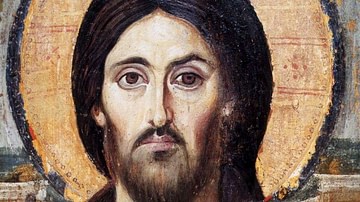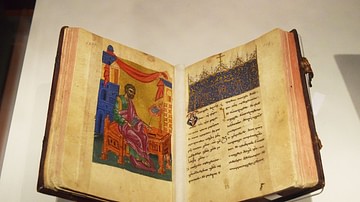
The Christian doctrine of the Trinity (from the Latin trinus, meaning "threefold") professes that there is one God, but three eternal and consubstantial persons (aspects): the Father, the Son, and the Holy Spirit. The Father is the God of Israel (the creator God of Genesis), the Son is the historical Jesus of Nazareth, and the Holy Spirit is the presence or spirit of God that binds them together. The word 'trinity' appears nowhere in the Bible; the concept was finalized at the First Council of Nicaea in 325 CE after years of debate. It was an attempt to articulate Christianity’s belief in the oneness of God with their claims about Jesus and their experiences of the spirit.
Jewish Monotheism & Jesus as Divine Being
Our modern concept of monotheism is defined as the belief in one God, but the ancients did not articulate their views as belief, what they did, their ritual acts were more important. Jews acknowledged the existence of other powers - the Jewish 'heaven' was populated with gradients of divinity; archangels, angels, cherubim, and seraphim - but they were commanded only to worship one. Worship in the ancient world consisted of sacrifices.
We do not know exactly what happened when the disciples experienced the resurrection of Jesus; no one wrote anything down. However, most scholars agree that they experienced something—either physical or spiritual, or perhaps a vision. The gospels claimed that Jesus "ascended into heaven" and Saint Stephen envisioned Jesus "standing at the right hand of God" in his vision before he died (Acts 7:55). In the 1st century CE, there were many stories that the patriarchs of Israel and the Maccabee martyrs were in heaven, in a concept known as the "vindication of the righteous." This may have been the initial understanding of Jesus as (now) among those in heaven.
The Letters of Paul
Paul, a Jewish Pharisee writing in the 50s-60s CE, also had a vision of Jesus in heaven. A voice told him to be the apostle to the Gentiles (non-Jews), and he created communities of believers throughout the Eastern Roman Empire. But as Paul had said, the suffering and death on a cross of God’s messiah was "a stumbling block to Jews and foolishness to Gentiles" (1 Corinthians 1:23). An unknown early Christian turned to the "suffering servant" passages of Isaiah 53-54 to rationalize what happened. Isaiah posited a suffering servant who was faithful to God but suffered, was tortured and killed. God raised him from the dead and placed him beside him on his throne. In the context of Isaiah, the suffering servant was the nation of Israel. Early Christians claimed that this was a prophecy for Jesus of Nazareth, now commonly referred to as Christ (Greek Christos for the Hebrew term “messiah”). An early hymn recited by Paul is found in Philippians 2:6-11, using many of the phrases from Isaiah:
[Jesus] Who, being in very nature God, did not consider equality with God something to be used to his own advantage; rather, he made himself nothing by taking the very nature of a servant, being made in human likeness. And being found in appearance as a man, he humbled himself by becoming obedient to death—even death on a cross! Therefore God exalted him to the highest place and gave him the name that is above every name, that at the name of Jesus every knee should bow, in heaven and on earth and under the earth, and every tongue acknowledge that Jesus Christ is Lord, to the glory of God the Father.
Christ, "being in the very nature God" produced the concept that Christ pre-existed and was present at creation. But at the same time, Paul also said, "But when the set time had fully come, God sent his Son, born of a woman, born under the law [of Moses]" (Galatians 4:4). Jews conceived of God as selfless, manifesting himself in history for the salvation of Israel. In the books of the Prophets, in the final days, God would reveal himself to all the nations. The Christian innovation here was to claim that the suffering servant was God himself, who humbled himself in the manifestation of the physical, earthly Jesus of Nazareth.

The line "every knee should bow" reflects the age-old bowing down before images of the gods. Paul said that all should worship Jesus, and as far as we know, this meant hymns and prayers to Jesus, petitions to Jesus, baptizing in his name, healing and exorcisms in his name, and his presence invoked in eucharistic meals (1 Cor. 1:2; 2 Cor. 12:8-9; 1 Cor. 16:22; Romans 10:9-13; 1 Cor. 6:11; Roman 6:3; I Cor. 11:17-34).
The Divine Jesus & the Role of the Spirit
By the time the gospels were written (beginning with Mark c. 70 CE), the worship of Jesus was reflected in the titles and actions of his followers. "Son of God", a term that had been applied to the Prophets, was literally understood. In Matthew’s nativity of Jesus, the reference to Emmanuel ("God is with us") reflects the divinity in Mary’s child. The angel’s announcement to Mary said, "The Holy Spirit will come on you, and the power of the Most High will overshadow you. So, the holy one to be born will be called the Son of God" (Luke 1:35). There are also references to God’s relationship to King David, "You are my son; today I have become your father." (Psalm 2:7, Acts 13:33).
After Jesus walked on water, "Then those who were in the boat worshipped him, saying, 'Truly you are the son of God'" (Matthew 14:33). Those who encountered the resurrected Jesus "worshipped him" (Matthew 28:17; Luke 24:52). When Jesus appeared to the disciples in the Galilee, Jesus said, "Therefore, go and make disciples of all nations, baptizing them in the name of the Father and of the Son and of the Holy Spirit" (Matthew 28:19.) This is not yet the concept of the Trinity, but it reflects the early, formalized ritual of baptism.
The "spirit," "the holy spirit," and the "spirit of God" appear 275 times in the New Testament, but this is not yet a separate entity from God. In Judaism, the "spirit of God" is equivalent to the "breath of God" that animated Adam, that possessed the Prophets, and the presence of God in the Temple. In this vein, when the dove descended on Jesus at his baptism, it symbolized God’s presence, acknowledging Jesus as his son. In Acts 2, the disciples receive the holy spirit at the feast of Pentecost, Peter then said, "Repent and be baptized, every one of you, in the name of Jesus Christ for the forgiveness of your sins. And you will receive the gift of the holy spirit" (38). In Paul’s letters, being possessed by the holy spirit enabled believers to "speak in tongues," prophesize, teach, and heal. Over time, the spirit was literally claimed to be present in what became Christian sacraments.
Christianity in the 2nd Century CE
By the 2nd century CE, the demographics of Christian communities had changed; the majority were Gentile converts. The leadership (retroactively known as the Church Fathers) consisted of men who were educated in various schools of philosophy. Several philosophers such as Celsus and Galen had criticized Christian beliefs, and the Church Fathers responded by aligning them with shared philosophical views of the universe. John’s gospel called Christ the logos ("word"), a concept for the principle of rationality in Plato. By aligning the two, the Church Fathers claimed this as proof that Christ was pre-existent.
The Roman Empire began persecuting Christians for their refusal to participate in the state and imperial cults during the reign of Domitian (r. 83-94 CE). Not only were Christians guilty of atheism (disbelief in the gods) but conservative Rome also had a long-held prejudice against new religions. The Jews had been exempted from the state cults from the time of Julius Caesar (100-44 BCE), but Christians were not Jews, nor were they members of traditional native cults. The Church Fathers petitioned Roman emperors to exempt Christians from the state cults, but to outsiders, Christianity was not monotheism, Christians worshipped two gods.
Through the literary device of allegory, Justin Martyr (100 - c. 160 CE) claimed that each time God appeared in the stories, this was in fact a form of the pre-existent Christ. Therefore, Christians retained the oneness of God who emanated his word (the logos) in Christ. Christianity was not new; their beliefs were based on the ancient traditions of the Jews.
Tertullian (155-200 CE) was the first to use the Latin term 'trinity'. He described it as a "divine economy" as in the household or monarchy of God. God the Father laid out the divine plan, God the Son carried out the will of the Father, and God the Spirit motivated the will of God in believers (Adversus Praxean, 27). In the Western Roman Empire, churches had been using what was called The Old Roman Creed, or The Apostles’ Creed by the 4th century CE. It included trinitarian beliefs, but without the philosophical concepts that became part of Nicaea.
The Arian Controversy & The First Council of Nicaea
In 312 CE, Roman emperor Constantine I (r. 306-337 CE) converted to Christianity and simultaneously became head of the Christian Church. He promoted the unity of belief throughout the empire. The concept of the Trinity could have remained an intellectual endeavor only, but a controversy emerged in the city of Alexandria that spilled over into other cities (318-321 CE). Arius, a presbyter in Alexandria taught that if one believed that God created everything, then at one time, he must have created Christ. Indeed, the very terms the Father and the Son indicated that Christ was subordinate to God. The bishop of Alexandria excommunicated Arius, but other church leaders took his side. Riots broke out among the various factions in different cities.
In 325 CE, Constantine called for an empire-wide council to resolve the matter. The challenge was to articulate the way in which the oneness of God was also found in his transcendence (through the power of the Spirit) and his incarnate nature (taking on flesh in the Son). The meeting was held in Nicaea, near the new capital of Constantinople that was still in progress. Roughly 217 bishops attended along with their entourages. Constantine paid everyone’s travel expenses and room and board. In the discussions at the Council of Nicaea, various views were debated:
- Monarchianism - God as king who delegated his powers to the Son and Holy Spirit
- Subordinationism or Arianism - the Son was a creature, and subordinate to the Father
- Sabellianism - a perfect union between the Father and Son, and thus the Father was crucified in the Son. This concept was eventually declared heretical.
The debates on the Trinity were quite esoteric and included philosophical ideas of the universe. Was Christ homo-ousios, a being like the Father, or was he homoi-ousios, of the identical essence of the Father? Note that the difference is in an iota, a subtle difference in the Greek. The Council opted for the second choice in that God and Christ were identical in essence and that Christ was a manifestation of God himself on earth. Beyond the esoteric theology, however, the practical implication for the choice of Christ being identical to the essence of God was that it theoretically kept the monotheism of traditional Judaism intact. Having Christ identical to God, confirmed the view that Christ was pre-existent and helped to create the universe.
The choice bolstered the status of the Christian emperor. Over time, the imminent kingdom of God had faded. The kingdom was still to come but in the interim, the Christian emperor was to stand in for Christ on earth. The emperor should therefore have the identical power of God on earth as he rules. It is after the Council of Nicaea that Christian emperors started to be portrayed with a halo and the trappings of divine worship.
The Nicene Creed
The concept of a creed (from the Latin credo, "I believe") was a Christian innovation. With multiple native cults, there was no central authority that dictated what all should believe. The Nicene Creed formalized one system of belief that was promoted through the power of the emperor (and his legions). As such, any dissent from the Creed was now treason. Below is the English translation of the Nicene Creed:
We believe in one God, the Father Almighty, Maker of all things visible and invisible:— and in one Lord Jesus Christ, the Son of God, the only-begotten of the Father, that is of the substance of the Father; God of God and Light of light; true God of true God; begotten, not made, consubstantial with the Father: by whom all things were made, both which are in heaven and on earth: who for the sake of us men, and on account of our salvation, descended, became incarnate, and was made man; suffered, arose again the third day, and ascended into the heavens, and will come again to judge the living and the dead. [We] also [believe] in the Holy Spirit. But the holy Catholic and Apostolic church anathematizes those who say There was a time when he was not, and He was not before he was begotten and He was made from that which did not exist, and those who assert that he is of other substance or essence than the Father, or that he was created, or is susceptible of change. (Eusebius, Historia Ecclesiastica, Book VIII, quoted in Schaff, Volume 1)
With the emperor chairing the Council, most of the bishops agreed to the Creed, but two refused: Eusebius, Constantine’s court bishop, and of course, Arius who had been brought in chains from Alexandria. Both were sent into exile. However, after some of the bishops returned home, they contested it, which is why further Councils had to be called to achieve conformity. Those who sided with Arius, made their way east and north of the Black Sea area (the Balkans and Russia), converting people. These Arians were quite successful. Two priests, Cyril and Methodius, created an alphabet, Cyrillic, which is still used in Eastern and Russian Orthodox Churches. Many of the later invaders of the Roman Empire (Goths, Visigoths, Vandals, Huns) were Arian Christians.
Later in life, Constantine apparently had a change of heart; he recalled both Bishop Eusebius and Arius from exile and brought them to Constantinople. He chose Bishop Eusebius to baptize him on his deathbed. Arius died not long after he returned under mysterious circumstances. His followers claimed that he was poisoned, but his enemies considered this divine intervention. When Constantine died, the Empire was allotted to his sons in three parts which often led to conspiracies and civil war. With the ascension of Constantius II (r. 337-361 CE), the empire was ruled by an Arian Christian for a while.
The First Council of Constantinople
The First Council of Constantinople of 381 CE was called by Emperor Theodosius I (r. 379-395 CE) to unify the Eastern and Western Churches after Constantinople had elected an Arian bishop. At the same time, it was recognized that the Council of Nicaea did not clarify the role of the holy spirit. The Council of Constantinople condemned all forms of Arianism and added more details to the Nicene Creed:
[Speaking of Jesus]. . . and was incarnate by the Holy Spirit and of the Virgin Mary and was made man; he was crucified for us under Pontius Pilate, and suffered and was buried, and the third day he rose again, according to the scriptures, and ascended into heaven, and sits at the right hand of the Father. (quoted in Schaff, Volume 14)
These extra details were added in response to continuing Gnostic Christian views that Jesus did not become human but only appeared so. The function of the Spirit was now made explicit, too:
And in the Holy Spirit, the Lord and giver of life, who proceeds from the Father, who with the Father and the Son is worshipped and glorified, who spoke through the Prophets. (quoted in Schaff, Volume 14)
Finally, since some Christians had wanted a second baptism to remove their sins after the first one, a line was added at the end:
We acknowledge one baptism for the remission of sins; we look for the resurrection of the dead, and the life of the world to come. (quoted in Schaff, Volume 14)
The Filioque Controversy & the Modern Concept
In the 6th century, some churches added a clause to the description of the Holy Spirit: "The Lord and giver of life who proceeds from the Father, and through the Son" (Latin: filioque). Several of the Eastern churches claimed that this diminished the power of the Spirit. Ultimately, the debate over this clause (and other matters) brought about the separation of the Eastern Orthodox churches from the Western Latin churches in 1054.
Modern Christianity summarizes the concept of the Trinity as follows:
- The three aspects within the one eternal God are God the Father, God the Son, and God the Holy Spirit.
- God the Father is the eternal and uncreated source of power.
- God the Son (Word or Logos) is the eternal tendency of God to express himself, to create, and to manifest himself on earth.
- God the Spirit connects the Father to the Son and is manifest in the Church and the lives of believers.









